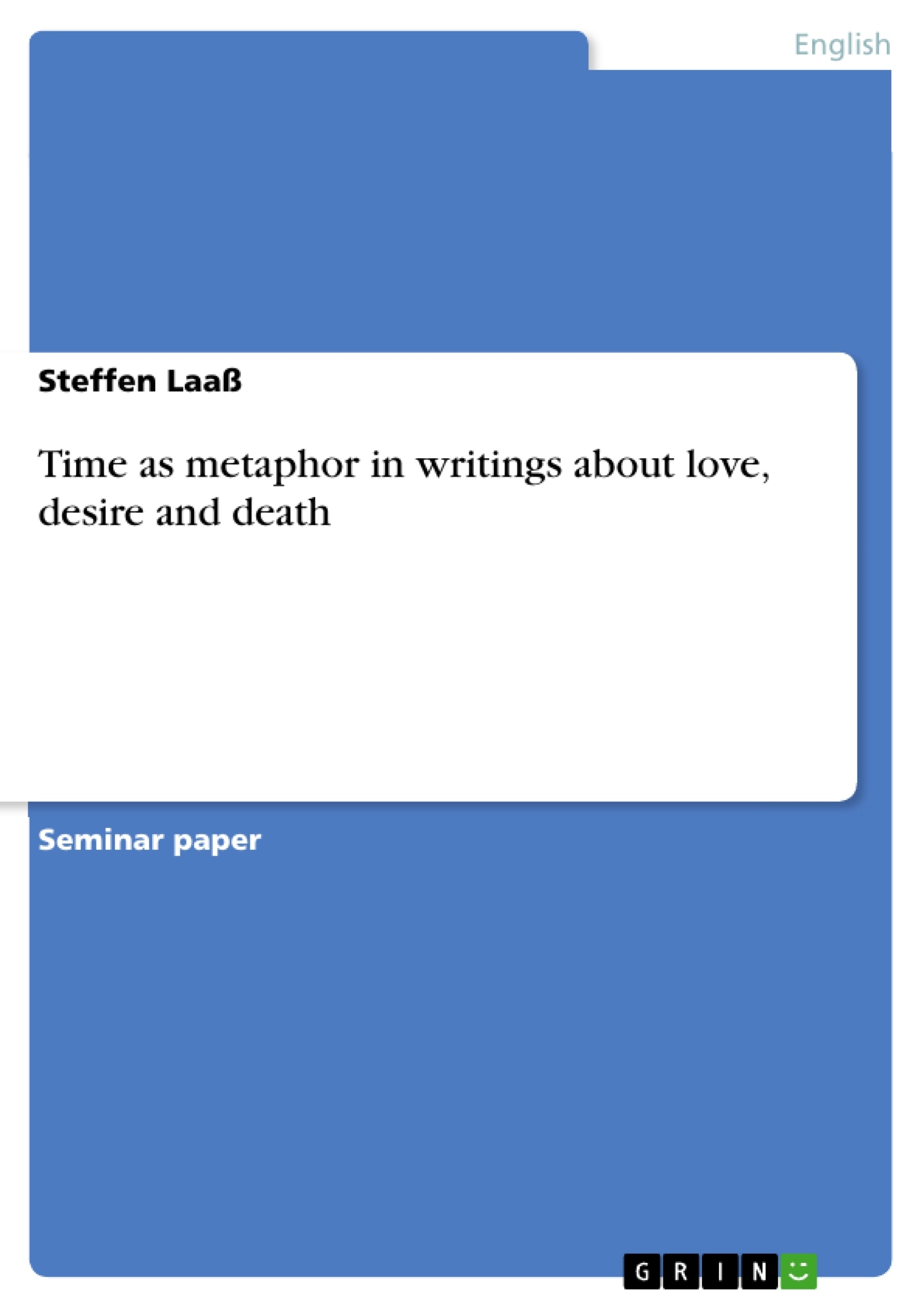Excerpt
Table of Contents
1. Introduction
2. Metaphorizing time
3. Turner’s classification scheme of time
4. The workings of time in Romeo and Juliet
5. Time in Lucrece
6. Time in Freud’s Mourning and Melancholia
7. Conclusion
Bibliography
Webliography
1. Introduction
The Renaissance was an exciting age. It was a time of exploration and discovery. People were eager for knowledge and keen on unravelling fundamental mysteries that make up their existence: What is Man? Which position does he take in the universe? What is he there for at all? Why is life so short? What is love?
Without generations being so inquisitive and inquiring, human progress would have come to a standstill. Luckily, people increasingly became aware of the fact that they are an integral part of nature’s changing course and controlled by an external force which is far beyond their power: time.
In this essay, the concept of time is of utmost interest. It shall serve as a microscope to examine literary and theoretical writings that deal with such fundamental issues like love, desire and death. Their readings are presented from a fascinating angle where time functions as a metaphor. To this end, three core texts will be explored: William Shakespeare’s tragedy Romeo and Juliet and his narrative poem The Rape of Lucrece, and Sigmund Freud’s Mourning and Melancholia.
Before we embark upon a ‘metaphorical reading’, I present an interesting framework that will come in useful when we investigate the texts. First, we study the relationship between time and metaphor.
2. Metaphorizing time
Let us imagine an elderly long-bearded man dressed in a robe. He is bald, but he has a forelock of hair. With him, he carries a scythe and an hourglass. Sometimes he is depicted cradling a baby in his arms … This mythical figure is commonly known as Father Time.
This example vividly shows how abstract ideas like that of time lose their obscurity and become more apprehensible by means of personification. However ungraspable the notion of time may be, personifying facilitates the determination of time’s typical features on a non-abstract level.
I must note at this point that, in this essay, I will not draw a distinction between the concepts of personification and metaphor because I regard personification as the ultimate metaphor achievable. When we are able to personify something, the abstract becomes us, like us – and it is the notion of ‘likeness’ upon which both personification and metaphor are based.
A neat example of how time is used metaphorically in everyday language is the common expression “Time flies”. Everyone knows the situation in which time passes rapidly when we are enjoying ourselves or have to make a quick decision. Here, time may stand for a bird that leaves its nest, flies away and disappears on the horizon. To catch it seems impossible. Equally, it is hard for us to make up for lost time.
Thus, metaphors declare that something is something else. We compare two seemingly unlike entities (e.g. time and bird) by omitting the words of comparison ‘like/as’: time is a bird, or time is a metaphor for bird. This way, the ‘metaphor makes a qualitative leap from a reasonable … comparison to an identification … of two objects … to make one new entity partaking of the characteristics of both’ (NEB: 1985: 62).
To conclude, metaphorizing often helps us to bring highly abstruse things to life. Thereby, the unintelligible and obscure becomes visual and graspable. Father Time is an excellent example for one possible metaphorical representation of time: his hour-glass symbolizes time’s constant movement, and his scythe stands for the passage of time towards the inevitability of death. Finally, his forelock finds its expression in the phrase ‘to take time by the forelock’.
Due to its complexity, the concept of time calls for systematisation and, if possible, simplification. In the next chapter, a system of classification will be briefly presented.
3. Turner’s classification scheme of time
Turner (1971: 3-5) offers a valuable framework in which he suggests nine major aspects of time:
illustration not visible in this excerpt
For our purposes, not all of the aspects are of equal interest. In addition, a writer may refer to one or more time representations at once. This overview is a helpful tool insofar as it serves as a starting point and greatly facilitates our exploration of the texts.
I shall now turn to the focus of this essay and offer readings from the perspective of time as metaphor, beginning with Shakespeare’s Romeo and Juliet.
4. The workings of time in Romeo and Juliet
Caught between banishment and an unwelcome choice, the young, isolated lovers
feel at enmity with the passage of time. … [T]heir desires are at odds with normal sequence, and they desperately seek to maintain their precarious happiness. But time moves steadily on.
(Quinones 1971: 371)
If you ask someone to name a typical ‘love story’, they will most likely think of Romeo and Juliet. Although there had existed various versions of the novella, it was William Shakespeare who created a masterpiece that not only literally, but also metaphorically ‘transcends time and place’ (Levenson 2000: 1).
However, Romeo and Juliet is far more than the embodiment of young romantic love. It also illustrates very well how the concepts of love, time, and fate are closely linked to and operate with each other. Acting as the three main driving forces in the play, they set the course of the plot and eventually lead to the ‘untimely’ deaths of the protagonists.
Apart from being an extraordinarily ‘speedy’ play, Romeo and Juliet is first and foremost a tragedy of unfortunate timing: ‘The lovers have bad luck. A few minutes at the tomb would have made all the difference’ (Turner 1971: 100).
[...]
- Quote paper
- Steffen Laaß (Author), 2005, Time as metaphor in writings about love, desire and death, Munich, GRIN Verlag, https://www.grin.com/document/70530
Publish now - it's free






















Comments